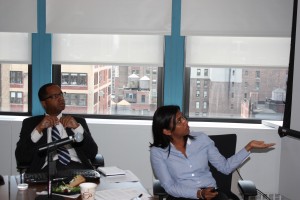Date
June 7, 2012
Related Links
Ms. Philip’s slides on school siting in New York City Ms. Giorgio’s slides on PCBs in New York City schools A toolkit designed to identify visibly leaking PCB lights at a school walk-through.New York City has the largest system of public schools in the United States with 1.1 million students, 75,000 teachers, 1,700 schools, and an annual budget of $24 billion. The City is faced with severe overcrowding in classrooms, and has launched an aggressive plan to build 56 new schools over the next five years. However, given the scarcity of affordable land, many of these schools are being sited on property contaminated with toxins, in buildings formerly used for industrial purposes, and on sites close to sources of pollution. Toxins commonly found at contaminated sites–including benzene, toluene, and lead–have been linked to increased cancer risk, decreased cognitive functioning, and respiratory ailments. “While Community Boards and the City Council have formal oversight roles in the siting process, they often lack the expertise and resources to ensure a healthy school siting,” said Ms. Philip. This problem is particularly acute in low-income communities, where formerly industrial properties are prevalent.

Despite the serious health risks, many school sites do not go through a robust environmental review process, which would include a thorough consideration of clean-up measures as well as regular opportunities for public review and comment. Although State law requires the School Construction Authority (SCA) to submit plans for a new school to the local Community Board and City Council, attend a Community Board hearing on the proposed site, and receive public comments, a leasing loophole enables them to bypass most–if not all–of these requirements. Consequently, schoolchildren are unnecessarily exposed to toxins because the SCA uses this loophole to avoid providing remedial measures for schools sited on contaminated property.
The discovery of polychlorinated biphenyl (PCB) in public school buildings has opened up a plethora issues, ranging from public health to public safety and community engagement. At least 950 schools–more than 50% of all public schools–are believed to contain PCB-contaminated window caulk and ceiling light fixtures. Although the City has proposed a 10-year plan to test and remediate PCBs found in schools, NYLPI filed a lawsuit against the Department of Education (DOE) and the SCA to expedite the removal of the light fixtures. The majority of the lights that are leaking throughout the school buildings are not visibly noticeable, but are just as harmful. “The DOE has adopted a visual inspection program that is totally inadequate because most of the leaks cannot be detected from just looking at the exterior of the light fixture,” said Ms. Giorgio. She also strongly recommended that parents conduct a school walk-through to look for visibly leaking PCB lights in order to fast track light removal at their child’s school. In schools where visible signs of leaking are found, the DOE has said it will remove all the PCB lights within one year.
Learn more about NYHealth’s support for NYPLI.
View Ms. Philip’s slides on school siting in New York City.
View Ms. Giorgio’s slides on PCBs in New York City schools.
View a toolkit designed to identify visibly leaking PCB lights at a school walk-through.
